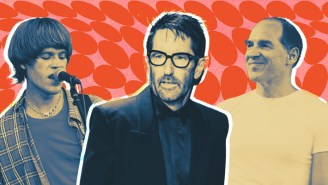They’re two lefty point guards with divergent career paths, and while one has grown with the same group in Memphis while becoming one of the better young point guards in the game, the other has dealt with new coaches and teammates and a not-undeserved reputation as a gunner. Mike Conley might have been in the same boat as Brandon Jennings if he’d landed in Milwaukee coming out of Ohio State, but now they both have similar squads around them.
With Marc Gasol and Zach Randolph supporting him from the front-court, Mike Conley has thrived in a Memphis Grizzlies offense predicated on smart, interior passing, and the ingenuity of Conley to get to the rim. He’s never needed to carry the offense and his offensive efficiency has reflected that luxury. But Brandon Jennings never had those types of teammates in Milwaukee with a host of poor supporting players—at least on the offensive end, since Larry Sanders has developed into a smart rim-protector—and his gunner mentality could be conceivably be attributed to the necessity he shoot on a team that might not have been able to score otherwise.
Now defensively, Jennings fell off in the latter portion of the 2012-13 season, routinely getting burned as he ball-watched on the perimeter and ignoring a lot of his assignments to the detriment of his team. Conley, while sporting a nice steals average, has been buttressed by the perimeter defense of Trick-or-Treat Tony Allen, perhaps the best perimeter defender in the league.
With Jennings just inking a three-year $24 million deal as part of a sign-and-trade sending him to Detroit, he gets a new start with a triumvirate of front court players—Andre Drummond, Greg Monroe and Josh Smith—that rival Conley’s Gasol and Z-Bo support on the block and elbow. So things are a bit more even in terms of supporting cast, and it begs the question: who’s better?
We argue. You decide.
… … …
BRANDON JENNINGS
Everyone has seen that guy hanging around at a school dance, waiting to get someone to notice him. The guy is cool, has a strong reputation and a good crew of friends. So the question is, why isn’t anyone dancing with him? Expectations. The man has his eyes set on the dime in the middle of the dance floor, but conceivably that doesn’t really sound like a legitimate option for him. Regardless, he holds his ground and begins to become less and less appealing to the opposite sex for his stubbornness and unwillingness to compromise.
We can now call this the “Brandon Jennings” of free agency, a perfectly capable player who had his value shoot down because of his determination for a big-time contract. Jennings eventually was sent to Detroit in a sign-and-trade deal that landed him a three-year, $24 million.
The overall argument is whether Jennings is a better player than Mike Conley Jr., a player who recently played the best basketball of his career. Jennings didn’t have the best year of his career and was maddeningly inconsistent for the Milwaukee Bucks. I’ll give you reasons why Jennings hasn’t been coached correctly and how he hasn’t even properly tapped into his potential. Along with those two things I’d like the readers to remember that the two players are polar opposites in how they play the game and that Jennings is two years younger.
Jennings is a statistical anomaly, a player that shoots first and asks questions later. He has shot more than 14 times a game since his rookie season in 2009 due to a mediocre cast around him. Jennings has had the “pleasure” to have John Salmons, Stephen Jackson, and Monta Ellis as his second scoring option. Ellis is, by far, the best scoring threat on this list but he never complemented Jennings. Conley has played with Rudy Gay, Marc Gasol, and Zach Randolph. Conley even had the luxury of playing with Greg Oden at Ohio State, taking away much of the pressure that he would have had to face otherwise.
So Jennings didn’t have a great second option, what else caused his inefficiency? The biggest issue Jennings faced was the coaching style of Scott Skiles. Jennings admittedly isn’t very good on defense, he actually is quite bad, but the Skiles system did not bring out the best in Jennings. It mired him in a defensive oriented system that wore out the players and eventually led to some disgruntled players.
Jennings eventually became one of those players. A guy who finally broke down in a city that started to lose him, as did his coaches. He couldn’t get along with his coaches because a clear distinction was written about him being the superstar that was never going to get superstar money, and he wanted the money.
The Bucks forgot that Jennings had averaged 16.1 points and 5.9 assists during his tenure in Milwaukee. The city got to witness his 55-point outburst in 2009, his rookie season, which was the year that the Allen Iverson comparisons began.
Jennings never lived up to the Iverson billing in Milwaukee but a new chapter has started in Detroit where he will get to pair his talents with Josh Smith. With such a dominant and highly efficient front-court of Andre Drummond and Greg Monroe, Jennings and Smith will be able to satiate their propensity to shoot. For Jennings to finally tap that potential, it will be up to nre coach Maurice Cheeks to adequately incorporate Jennings into a fast-paced offense.
The 23-year-old has a lot to give to this game and has flashed the potential to flat out dominant the game, something that Conley hasn’t quite done.
-THOMAS RENDE JR.
MIKE CONLEY
At first glance, Brandon Jennings and Mike Conley Jr. have a lot in common. They’re both lightning fast, lefty point guards who entered the league with overblown expectations.
Conley was selected fourth overall in the 2007 NBA Draft after leading his Ohio State Buckeyes, along with Greg Oden, to the NCAA Championship game—where they ultimately lost to Florida.
Jennings, however, took a more circuitous route to the NBA when he decided to eschew his requisite year in the collegiate ranks and opted instead to play in the Italian League with Virtus Roma until he was eligible to enter the NBA Draft in 2009. But his year abroad raised more questions than answers as he struggled to adjust to the Euroleague style of play, recording underwhelming averages of 5.5. points, 2.3 assists, and 1.6 steals per game in limited minutes. Nonetheless, Jennings was selected 10th overall by the Milwaukee Bucks and showed flashes of brilliance during his rookie season, most notably his 55-point game against the Golden State Warriors, a franchise-best single-game scoring performance by a rookie.
But over the past four years, Jennings has struggled to evolve into the top tier point guard that many were expecting him to become, and consequently, his future had been hanging in limbo all summer long until the Pistons dealt for him last week.
Prior to that, there’d been a lot of discussion as to how the feisty point guard could have fallen so far out of favor. After failing to receive a contract extension from the Bucks this year, his only hope was to get traded to a new team or reluctantly settle for a one-year qualifying offer for significantly less money than he believes he’s worth. The writing was on the wall after the Bucks extended an offer sheet to restricted free agent point guard Jeff Teague, but the Hawks ended up matching that offer, and until the Pistons stepped in, it looked like Jennings and the Bucks might be destined to spend one last miserable year together.
Conley found himself in a similar situation back in 2010 after a somewhat disappointing start to his career, but the Grizzlies brass saw something in the scrappy young floor general and awarded him a mind-boggling five-year $45 million contract that many at the time considered patently absurd for a largely unproven player. But during his first four seasons, Conley actually improved his regular season averages for points, assists, and steals each year, and during the 2010-2011 season, he set the Grizzlies franchise record for total steals during a single season with 144.
While Conley has evolved into one of the league’s better defenders at his position, Jennings continues to be a defensively liability to his team. According to 82games.com, the Bucks allowed opponents 9.2 fewer points per 100 possessions when Jennings was on the bench last season. The Grizzlies, by comparison, allowed opponents 0.7 more points per 100 possessions with Conley on the bench.
True, Jennings is capable of ratcheting up on defense from time to time and coming up with errant steals. After all, he averaged 1.6 steals per game this season, but more often than not his gambles on defense don’t pay off, and he regularly finds himself out of position. In the process, he leaves his help defenders hanging out to dry against the league’s speediest point guards. With his size disadvantage, Jennings also tends to struggle against bigger point guards and isn’t particularly good at defending the pick-and-roll.
According to ESPN, Conley ranked number one in the league last year in defensive win shares among all guards. He also ranked first in the league in points per isolation, ahead of LeBron James, Kyrie Irving, and Tony Parker, so not only is Conley a better defender; he’s also a better one-on-one scorer.
This past season, Conley averaged 14.6 points, 6.1 assists, and 2.2 steals per game, while shooting 44 percent from the field and a respectable 36 percent from three. Jennings averaged a few more points per game than Conley this season (17.5), but he did it on 39 percent shooting, a dubious mark by any standards.
If you compare their most recent playoff averages, it really isn’t much of a debate, even given the caveat that Conley is surrounded by considerably better talent (more on that in the video below). While leading his team to their inaugural Western Conference Championship appearance, Conley averaged 17 points (a couple of points above his regular season average), 7.1 assists, and 1.7 steals in 13 playoff games, while Jennings stumbled his way to 13.3 points (a few points below his regular season average), 4 assists, and 2.2 steals, on positively abysmal 29 percent shooting.
If that wasn’t enough, Jennings’ Player Efficiency Rating took a nosedive to +9.9 while Conley’s was the highest of his career at +18.8 (which admittedly is only a few points above the league average +15). But the biggest knock on Jennings by far has to be his horrendous shot selection. Just how bad is it? Take a look below at recent video breakdown featured on SB Nation earlier this week.
Jennings settles for far too many three-pointers and long, off-balance twos, and an alarming number of his shots come from the least efficient spot on the floor, the elbow three.
Even when it comes to ball-handling, it’s debatable whether Jennings is any better than Conley. Sure, Jennings has a flashier array of moves in his repertoire, but you could easily argue that Conley’s more subtle combinations of hesitation moves, in-and-out dribbles, and basic crossovers allow him to get more places on the court and carve up the defense more effectively.
Being a southpaw in the NBA offers a number advantages for both of these players; that is, of course, if you can finish around the rim with either hand. It’s what makes the ambidextrous Conley so difficult to defend, while Jennings, on the other hand (pun totally intended), relies almost exclusively on his strong hand.
When it comes down to it, the comparison is rather simple. Jennings is a high-volume, shoot-first point guard with a low field goal percentage who isn’t particularly adept at setting up his teammates or defending at his position, while Conley is a vastly more efficient, pass-first offensive facilitator who can take opponents off the dribble going left or right and is one of the best defensive point guards in the NBA.
Nonetheless, Jennings should benefit enormously from playing with an efficient, defensive-minded veteran like Chauncey Billups in Detroit for the foreseeable future.
-JAMIE COOPER
Who do you think is better?
Follow Jamie on Twitter at @WinoCarpenter.
Follow Tom on Twitter at @Trende19.
Follow Dime on Twitter at @DimeMag.
Become a fan of Dime Magazine on Facebook HERE.






